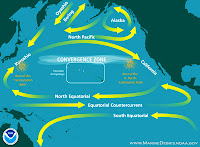The microplastic
accumulation in the Great Pacific Garbage Patch has increased 100-fold in the last
40 years, according to a study
published this week in the Biology Letter of the Royal
Society. This
giant non-biodegradable persistent waste patch is around the same size of Texas
and its impacts can be nasty.
If not
disposed of correctly, solid waste (plastic bags, balloons, glass bottles,
shoes, packaging material etc) always finds its way to the oceans. Gyres are areas of convergence that
accumulate loads of plastic and other litter, mostly small fragments less than
5mm in diameter, known as microplastic. Some
of the most serious impacts of microplastic include the transport of pollutants
and the introduction of alien species as well as the risk of ingestion by
seabirds, turtles, seals, sea lions, whales, fish and invertebrates. And if fish eat contaminated plastic, these substances
might as well end up on your plate.
According
to a Greenpeace report,
around 80% of marine debris is from land-based sources, while 20% is from ocean-based
sources such as ships. From these,
plastic makes up 60-80% of all marine litter.
It would be almost impossible to force countries and governments to “clean”
the seas: the costs would just be too high.
However, only a “Zero Waste” strategy, together with tight regulation,
could keep litter away from our oceans.
To learn
more about the Seas of Plastic, watch this excellent TED talk by Capt. Charles
Moore of the Algalita Marine Research Foundation,
who first discovered the Great Pacific Garbage Patch.
Post by Ana Catarino


No comments:
Post a Comment